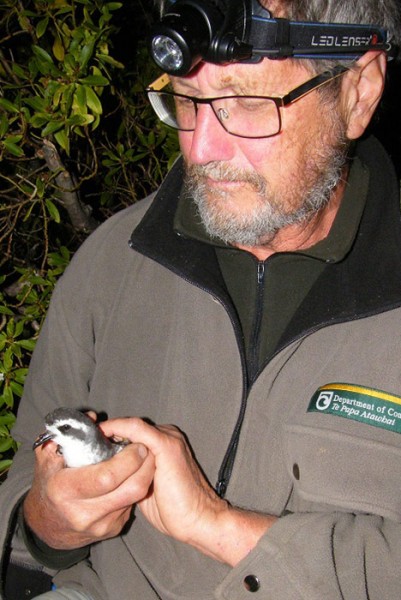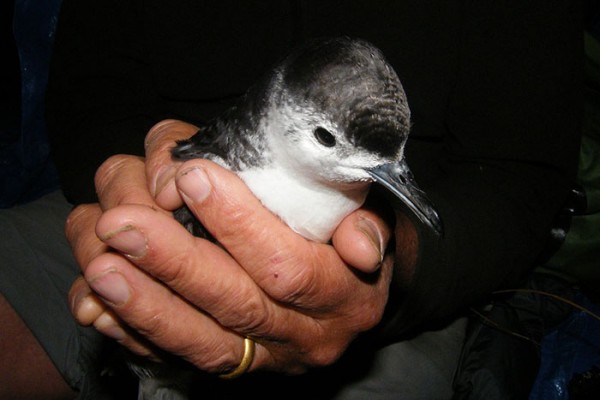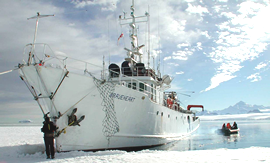While the whale team have been going great guns chasing those marine leviathans at sea, we shifted our land-based focus from medium-sized seabirds to the small ones. When invasive aliens (rats, cats, etc.) make their way to an oceanic island like Raoul for the first time it is the little guys that are most likely to be hammered first; easy prey especially for rats, including Pacific rats or kiore.
There is no historical record of either Kermadec Little Shearwaters or Kermadec Storm-petrels breeding on Raoul prior to the eradication in 2004 so these two species can be presumed to have disappeared from the island by the 19th century. Most likely before.

Chris holds a Kermadec storm petrel.
So when we found some active smallish burrows in forest just above one of our Kermadec Petrel sites (Wilson Point) we thought that either some Black-winged Petrels had returned early (there are heaps of Black-winged burrows at this location but we haven’t seen any flying around) or the activity was being made by something else. We deployed a natty little DOC remote recorder which I’d been carrying and let it run for a few days while we headed off elsewhere.
There’s always real anticipation in what might show up when downloading sound files and scanning the spectrograms, and listening to the audio for anything interesting showing up. And sure enough we found that Kermadec Little Shearwaters vocalising strongly around 8 to 9.30pm each night and then near dawn around 5am with scattered calls between. This required a definite follow up and last night Mark and I headed back to the Boat Cove and Wilson Point to bivvy out overnight and find what was going on. We were on site at dusk and after sorting out our gear, were sitting quietly in the dark looking for any overhead action. Not long after a bird flew over us (8pm) we heard a bit of rustle in the leaf litter immediately behind us. Mark had a look under the low ngaio next and came out with a Little Shearwater. Whooppee time and photos! After releasing the little guy we saw more flying overhead and heard birds calling below us down towards the cliffs. The colony was bigger and more spread out than we thought could be the case.
Then came the OMG moment. Once again we were back at our bivvy site (no lights, no sound) with an evening mocca-coffee when we saw a bird flying up the narrow ridge towards us. It landed in the pohutukawa over our heads when we flicked a headlamp on and then fluttered down – a Kermadec Storm-petrel! We knew we had hit the jackpot when we saw more of them in our lights.
Kermadec Little Shearwaters had been attracted to the lights of the DOC base in 2009, and one pair had been found breeding at Rayner Point in 2011 but I hadn’t received any follow-up reports from that location – just Black-winged and Kermadec Petrels. Kermadec Storm-petrels, which are certain to breed on the Meyer Islands, although this hasn’t been confirmed with a sighting of a bird over land or in a burrow, have also been attracted to the lights of the DOC base on at least a couple of occasions.
We estimate the numbers of Kermadec Little Shearwater at Wilson’s Point as being at least 50 pairs but likely over a 100 pairs. The storm-petrels were silent in flight and could easily be breeding in very small burrows under grass, possibly in the small patches of forest or even in amongst the ferns and rushes. The only confirmed breeding site for these storm-petrels is Haszard Island next to Macauley Island in the Southern Kermadecs. We are confident they are now on Raoul and the focus of surveys in years to come.

Chris and Mark estimate there are at least 50 pairs of Kermadec Little Shearwaters at Wilson’s Point.
We managed to get some sleep through the early hours until around 5am when once again we heard a rustling under our little ngaio. I managed to snap our little friend as it emerged beside Mark before it flew out to sea. We heard good numbers of the shearwaters departing until about 5:30. All this pre-dawn action was accompanied by the constant sound of waves on the rocks at the base of the cliffs and a number of whales close by, blowing, breaching and tail/fin slapping; sounding like cannon shots. A 40 gun salute to share our celebrations perhaps!
By Chris Gaskin












